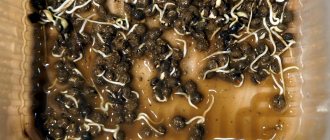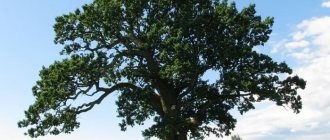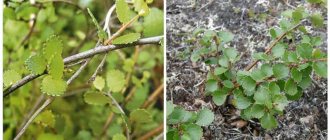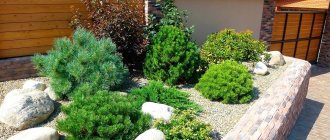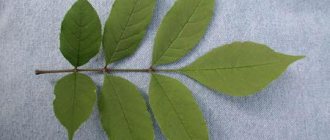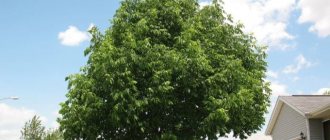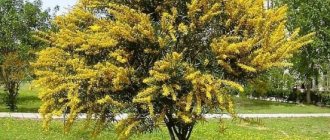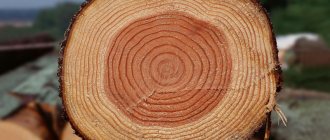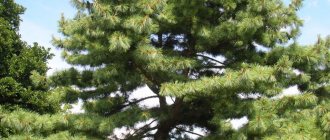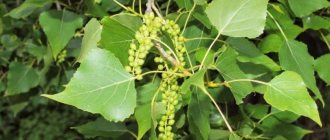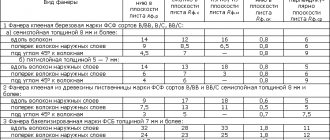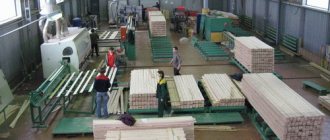Norway spruce (Picea abies) is the oldest evergreen species of the pine family, a slender and beautiful long-lived woody plant with a pyramidal wide crown. In nature it reaches 50 m in height. Its straight trunk can reach 1 - 2 m in diameter. The top of the spruce is always sharp, the branches grow horizontally or arched upward. The bark is red or gray. The needles are short, 15 - 20 mm long, bright green or dark green in color, with a characteristic aroma. Although we are talking about conifers as evergreens, in fact, the needles have their own lifespan: in spruce they stay on the tree for a maximum of 6 - 12 years.
Norway spruce is the most common coniferous plant in Russia, the main forest-forming species. In nature, you can find trees over 250–300 years old.
The cones of Norway spruce are oblong and cylindrical. During their life they change color from red to green, and as they mature they become brown. Thanks to the wings, the seeds are easily dispersed by the wind. The harvest ripens every 3-4 years, but old cones can hang on the tree for more than one year.
In different cultures, spruce is considered a symbol of eternal life, courage and fidelity. But in Rus' they never planted it near the house - it was considered a bad omen. All because it burns well... And if suddenly there was a fire in a house, the tree would flare up like a match, fall and spread the fire to other houses. But now it is readily planted in many areas: dwarf varieties and non-hot materials for construction have appeared.
Varieties of Norway spruce
But now common spruce is very popular in landscape design due to its frost resistance, shade tolerance, and most importantly, its variety of varieties.
Nidiformis. Belongs to the dwarf subspecies of common spruce. This compact, beautiful plant has long won its place in small gardens. The shrub with an original flat-rounded (in young trees it is nest-like), very dense crown of thin branches with light green needles reaches only 1 - 1.2 m in height and 2.5 m in width. But it takes a long time to grow to this size - in 10 years the spruce will barely be 40 cm.
This variety is very winter-hardy and can withstand air temperatures down to -40 °C without problems. It is undemanding to soils, although it grows better in fresh, moist soils. It grows successfully in both full light and partial shade.
The variety was introduced into cultivation at the beginning of the 20th century. Used by landscape designers in rocky gardens and low borders (1). There is positive experience in growing Nidiformis in containers.
Acrocona. One of the most picturesque varieties, known since the end of the 19th century. Its irregular wide columnar crown shape and asymmetrically and arched hanging branches give the garden lightness. An adult Acrocona reaches a height of 3 m with a crown width of up to 3 m. The dark green needles are short and stay on the branches for up to 12 years. The real decoration of the tree is the numerous beautiful large cones that grow in an original way at the ends of the shoots. At first they are bright red, then turn brown.
Spruce Acrocona. Photo: Jagel, globallookpress.com
The variety grows slowly, withstands frosts down to -40°C, is light-loving, prefers fertile and moist soils with a slightly alkaline reaction.
In landscape design it is valued as a tapeworm (single plant). It is often used to create rocky and Japanese gardens.
Inversa. One of the most interesting variations on the “weeping spruce” theme. It was found in England in 1884. A tree with a narrow crown, cascading branches forming a trail on the ground. It is grown as a slow-growing shrub on a support, or grafted onto a tall trunk. The hanging branches fit tightly to the trunk, so even in an adult tree the crown diameter does not exceed 2.5 m.
Spruce Inversa. Photo: pixabay.com
The Inversa variety (2) is very winter-hardy (withstands down to -40 °C) and can grow even in harsh mountain conditions. Loves bright places, but can also grow in partial shade. Prefers moist, nutritious soils, tolerant of both acidic and alkaline soils.
In landscape design it plays the role of a spectacular tapeworm.
Will's Zwerg . It began to be actively sold in 1956. Low-growing, slow-growing, by the age of 30 it gains 2 m in height, but barely reaches 1 m in width. The crown is beautiful, dense, pin-shaped or conical. It looks very elegant and impressive at the beginning of the growth of shoots, which stand out with yellow-orange growth against the background of dark green paws. And in summer, young shoots differ in color - they are light green.
The variety is very winter-hardy (up to -40 °C), light-loving, although it can grow in shady places. It needs well-drained, moderately fertile soils.
In the landscape design of small gardens it is used as a tapeworm and in groups as a background plant.
Little Gem . One of the smallest and slowest growing spruce mutations. Discovered in the 50s of the last century in Holland. The crown is cushion-shaped, dense, the branches are short, slightly raised. The needles are tender, thin, dark green. In spring, against this background, young growth with bright green needles looks very impressive. By the age of 10, the Christmas tree grows to a height of only 20 cm. And after 50 cm, its growth stops. A characteristic feature of this dwarf is that it never blooms.
Spruce is frost-resistant (up to -35 °C), light-loving, prefers moderately moist and nutritious soils.
In landscape design it is used in miniature and small gardens, in rockeries and screes, and is effective in containers.
Features of landscape design
Landscape designers use all types of spruce in their work. But their use depends on the type and variety.
Before planting a tree, you need to consider the following:
- Christmas trees with dove or blue needles will set off the green lawn;
- tall plants are not suitable for small areas. But on an area of 12 acres or more, they will help to beautifully frame the facade of a house or build an alley;
- any garden can be diversified by planting low-growing Christmas trees in a group;
- conifers and rhododendron cannot be neighbors;
- low-growing and dwarf Christmas trees are suitable for any territory and will be appropriate there;
- if you plant dwarf Christmas trees next to flowers, the composition will look impressive.
Attention!
Trees have shallow roots, so other crops must be planted at least 2 m away from them.
- You can supplement the pine needles with decorative bushes, but not with a red crown;
- dwarf Christmas trees are well complemented by daffodils, tulips and scillas;
- You can use representatives of conifers to create a hedge.
In addition, landscape designers note some advantages of planting a Christmas tree on any site. Here we are talking about decorativeness, regardless of the season. Also, culture will fit into any design and the design style is not important. In addition, planting spruce purifies the air and has a positive effect on health.
Planting Norway spruce
An important rule: before purchasing a seedling, you must clearly determine the planting location, realizing what size the plant will be in 10 - 20 years. Spruce trees are not plants that can easily be transplanted. For plants with a closed root system (ZKS), the best planting time is from mid-April to October, for seedlings with an open root system - until mid-April and the second half of September - early November.
The best option is seedlings in a container or with a packed earthen ball. The planting pit must be prepared in advance.
It should be remembered that young plants may suffer from sunburn in the first two winters, so protection from drying winds and bright sun at the end of winter is needed.
Caring for Norway spruce
The varieties and forms of common spruce are varied, very winter-hardy (with rare exceptions), some have peculiarities in care, but most often basic knowledge is enough for the plants to develop and grow beautiful, healthy and durable.
Priming
Norway spruce develops best in moderately moist, well-drained, fairly fertile soils. Ideally, slightly acidic rich loams. Some varieties require a slightly alkaline soil reaction, but in general spruce trees grow well in slightly acidic and neutral soils. On poor sandy soils, when planting in holes, add clay and humus in a 1:1 ratio.
Lighting
Most varieties tolerate direct sunlight well, but in the first two winters, dwarf forms need shading. Many varieties are shade tolerant, but a beautiful crown shape is formed only with sufficient sunlight.
Watering
In nature, Norway spruce grows on moderately moist soils, although many spruce forests are found in mountainous areas where there is not much moisture. However, when planting, all varieties of spruce require high-quality watering, especially in the first year.
After planting, watering is needed once a week at the rate of 10 - 12 liters of water per seedling no more than 1.5 m high. In hot weather in the evening or morning, a shower has a beneficial effect. To preserve moisture, tree trunk circles can be mulched with a thick layer of bark or softwood sawdust.
After a year or two, most varieties of common spruce no longer need watering, although they respond well to a water shower on hot days.
The most important condition for a good wintering of young plants is moisture-recharging watering. No matter how wet the autumn may be, in October you need to pour at least 20 - 30 liters of water under each coniferous tree for small plants and 50 liters for each meter of crown height.
Fertilizers
When planting, phosphorus-potassium fertilizers and old coniferous sawdust are used. No manure or fresh compost, as well as any nitrogen fertilizer, or ash. For dwarf varieties, it is permissible to place half a bucket of well-ripened compost in the planting hole.
Feeding
On fertile soils, spruce trees do not need fertilizing in the first 2 - 3 years after planting. Subsequently, special fertilizers are applied to the tree trunk circles. When the needles turn yellow and fall off, as well as in the first year, it is useful to spray the crown with solutions of Epin and Ferrovit.
Habitat
Norway spruce is widespread in North America, northeastern Europe, the Alps, Carpathians, and the Balkan Peninsula. In the CIS countries it grows in the northern and middle zones, coinciding in the north with the border of forests and descending to the black earth zone.
The plant prefers moist, fertile loamy and sandy loam soils. As for its relationship to light, common spruce is shade-tolerant. It forms pure forests and is also part of mixed forests. Grows well in combination with common blueberry (spruce-blueberry), wood sorrel (spruce-sorrel).
Reproduction of Norway spruce
Spruces can be propagated in three ways.
Seeds. With this method, varietal characteristics are not preserved. However, this method is popular with those who need a lot of planting material and are in no hurry. With this growing method, it is important that the seeds are fresh and stratified.
Vaccination. This is an option for varietal plants - it allows you to preserve all the characteristics of the mother plant.
By cuttings. It is also used for propagation of varietal spruce trees. But it requires patience, time and compliance with a lot of rules.
Photo: commons.wikimedia.org
Cuttings for rooting are taken from mother plants on a cloudy day in late March - early April, torn from a branch with a heel - a piece of trunk bark. A good cutting should be 7-10 cm long. Immediately after harvesting, the ends of the cuttings are placed in a solution of a root formation stimulator (for example, Heteroauxin) for a day. Then the cuttings are planted in pots with light fertile soil at an angle of 30°, deepened by 2 - 3 cm. The pots are placed in a greenhouse or covered with a plastic bag. It is important to ventilate the plantings once a day.
Be patient - the rooting process can take up to one year. And during this period, it is important to regularly water and ventilate the plants. Once every 2 weeks you can add a weak solution of Heteroauxin to the water.
In the spring, rooted cuttings are planted in a schoolyard, which is arranged under the canopy of trees. Only after a year or two can the grown plants be planted in a permanent place.
Classification [edit | edit code ]
Taxonomy [edit | edit code ]
The species Norway spruce is included in the genus Spruce ( Picea
) family Pine (
Pinaceae
) order Pine (
Pinales
).
| International scientific name | |
| Species range [1] |
Synonyms [edit | edit code]
According to The Plant List
for 2013, the synonymy of the species includes [14]:
- Abies abies (L.) Druce, nom. inval.
- Abies alpestris Brügger
- Abies carpatica (Loudon) Ravenscr.
- Abies cinerea Borkh.
- Abies clambrasiliana Lavallée
- Abies clanbrassiliana P.Lawson
- Abies coerulescens K.Koch
- Abies communis P.Lawson, nom. illeg.
- Abies conica Lavallee
- Abies cranstonii Lavallée, nom. inval.
- Abies elegans Sm.exJ.Knight
- Abies eremita K.Koch
- Abies erythrocarpa (Purk.) Nyman
- Abies excelsa (Lam.) Poir.
- Abies extrema Th.Fr.
- Abies finedonensis Gordon
- Abies gregoryana H.Low. ex Gordon
- Abies inverta R.Sm. ex Gordon
- Abies lemoniana Booth ex Gordon
- Abies medioxima C.Lawson
- Abies minima Lavallée, nom. inval.
- Abies minuta Poir.
- Abies montana Nyman
- Abies mucronata Rausch ex Carriere, nom. inval.
- Abies parvula Knight
- Abies pectinata Gilib. ,nom. inval.
- Abies picea mill.
- Abies pumila Voss, nom. inval.
- Abies subarctica (Schur) Nyman
- Abies viminalis Wahlenb.
- Abies vulgaris Wender. ,nom. illeg.
- Picea alpestris (Brügger) Stein
- Picea cranstonii Beissn.
- Picea elegantissima Beissn.
- Picea excelsa (Lam.) Link
- Picea finedonensis Beissn.
- Picea gregoryana Beissn.
- Picea integrisquamis (Carrière) Chiov.
- Picea maxwellii Beissn.
- Picea montana Schur
- Picea remontii Beissn.
- Picea rubra A.Dietr.
- Picea subarctica Schur
- Picea velebitica Simonk. ex Kümmerle
- Picea viminalis (Alstr.) Beissn.
- Picea vulgaris Link
- Pinus abies L.
- Pinus carpatica Gordon, nom. inval.
- Pinus cinerea Röhl. ,nom. inval.
- Pinus clanbrassiliana Lodd. ,nom. inval.
- Pinus excelsa Lam.
- Pinus picea Du Roi, nom. illeg.
- Pinus pyramidalis Salisb. ,nom. illeg.
- Pinus sativa Lam.
- Pinus viminalis Alstr.
Diseases of common spruce
Rust (spruce spinner). This is a fungal disease. The disease manifests itself on the bark in the form of small orange swellings with a diameter of 0.5 cm. Then the needles begin to turn yellow and fall off. Cones can also be affected by rust.
It is important to collect diseased needles and cones at the initial stage, cut out and burn branches affected by the fungus, and treat the plants with Hom (copper chloride) (3) or Racurs. For prevention, spring spraying with Bordeaux mixture is practiced.
Schutte. Although this disease most often affects pine trees, schütte (snow mold) often affects Norway spruce. The culprit is a pathogenic fungus. It colonizes plants in the fall. It develops rapidly in winter, especially under snow. In spring, brown needles with a white coating appear on the plants. Sick needles can remain on spruce for another year. This leads to a halt in the development of the plant, and in some cases to death.
Treatment consists of removing the affected branches and treating the plants three times with Hom or Racurs (3).
Use in the national economy
Spruce plantations can often be seen in sanatoriums. Because their needles release phytoncides that clean and disinfect the air. Also, spruce often becomes the basis of landscapes in personal plots.
High-quality musical instruments are made from this wood. Soft wood is used to make paper, rayon, and smokeless gunpowder. Resin, tar, rosin, and turpentine are obtained.
Fir cones are widely used in folk medicine. Healers believe that a Christmas tree is a donor tree; if you lean against it and stand there for a few minutes, it will give a person energy and strength.
the forest guest for the New Year.
How much joy it brings, filling the house with a special forest smell and pleasing the eye with its beauty!
If this message was useful to you, I would be glad to see you in the VKontakte group. Also, thank you if you click on one of the “like” buttons:
Pests of common spruce
Spruce spider mite. The most common pest that reproduces most actively during the hot, dry months. Ticks pierce the needles, drinking the juices, leaving small yellow spots on them. With severe infection, the needles turn brown and fall off. Cobwebs appear on the branches.
Prevention - regular dousing of crowns with water. Treatment is spraying infected plants with Actellik, Antiklesch, Fitoverm. It is important to carry out at least 3 treatments from June to September.
Spruce sawfly. The small insect infests spruce trees with larvae, which eat the needles. It is not so easy to notice the sawfly invasion at first - the larvae literally merge with the needles. But when young needles become reddish-brown in color, urgent measures must be taken to protect the plants.
The drug Pinocid is effective against the sawfly. The tree is sprayed with the solution at least twice; it is also important to spray the tree trunk circles with the solution - the larvae are buried in the ground. In the initial stage of infection, spraying with Actellik or Fury is effective.
Spruce budworm. The butterfly moth infects spruce trees with larvae that bite into the needles, making mines. After some time, the needles become covered with cobwebs and fall off.
The drugs Calypso and Confidor are effective against leaf rollers. For minor damage, two or three treatments of the affected branches with Green Soap are sufficient.
Spruce moth. Often affects young plants. Small insects settle on the bark and needles, which is noticeable by the sticky coating. Plants become depressed, needles turn brown and fall off, branches bend and dry out.
The most effective against this pest are Aktara and Confidor.
